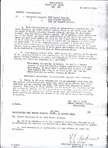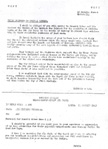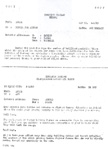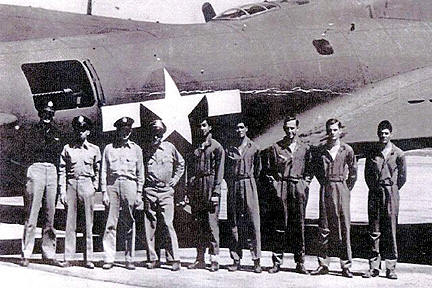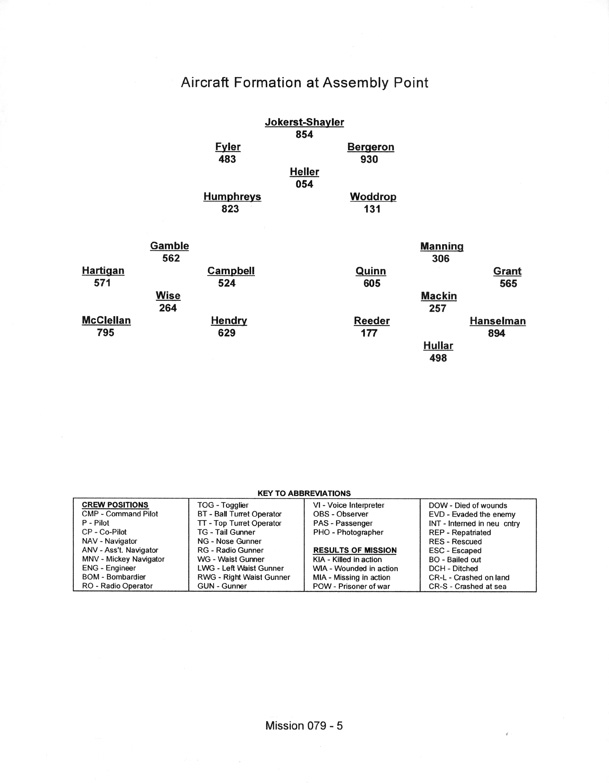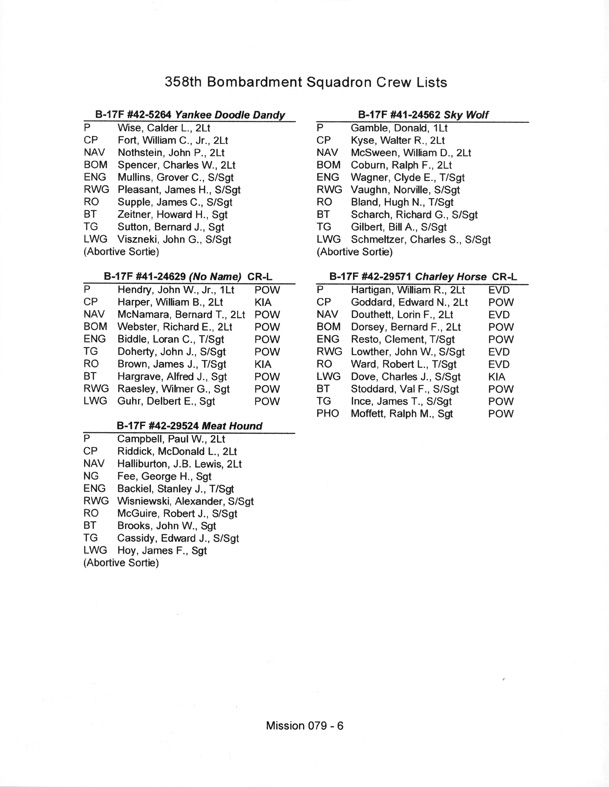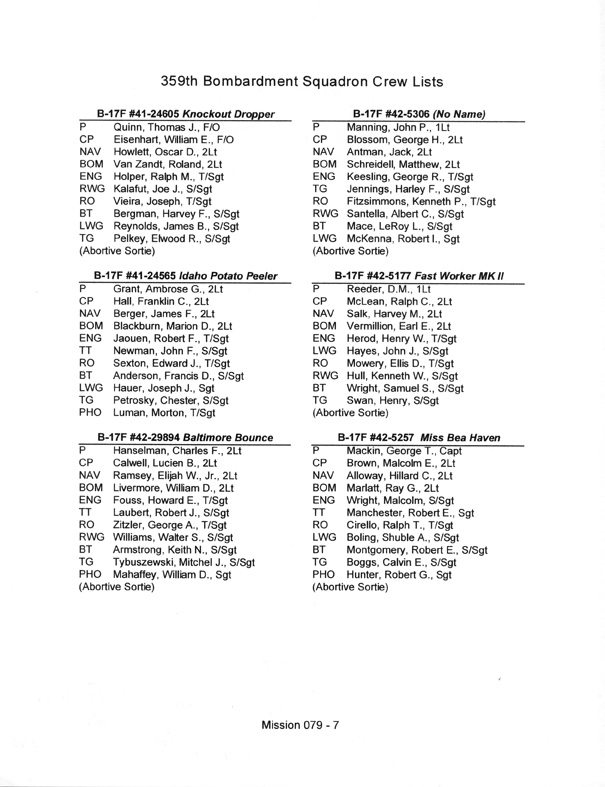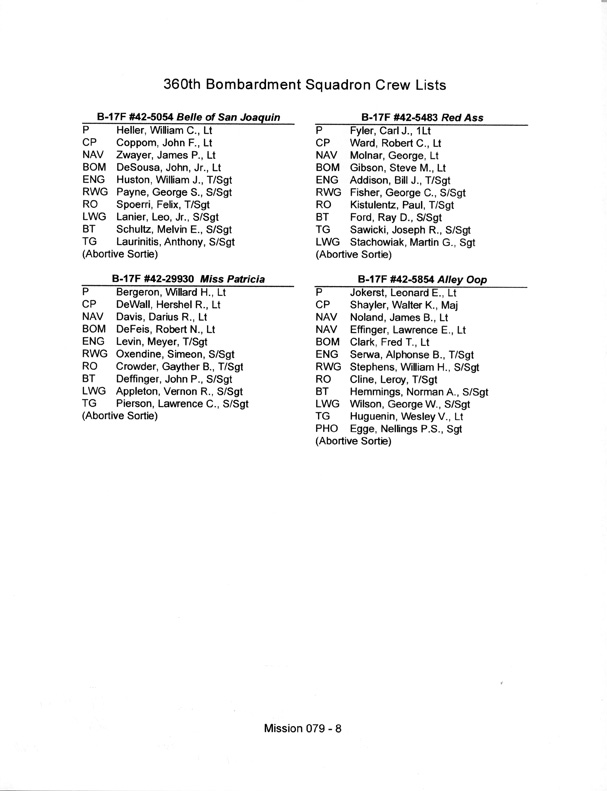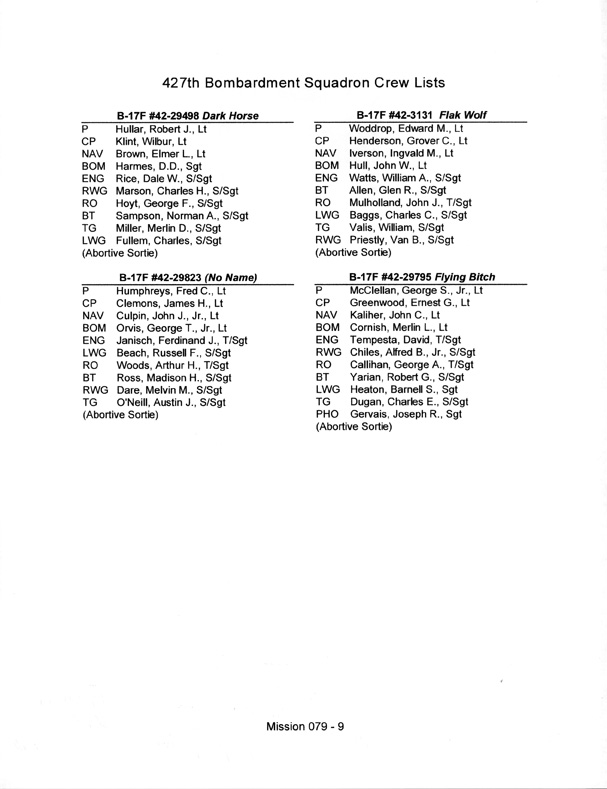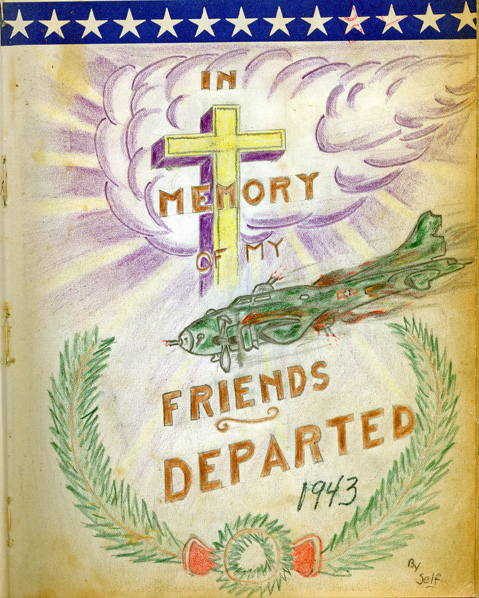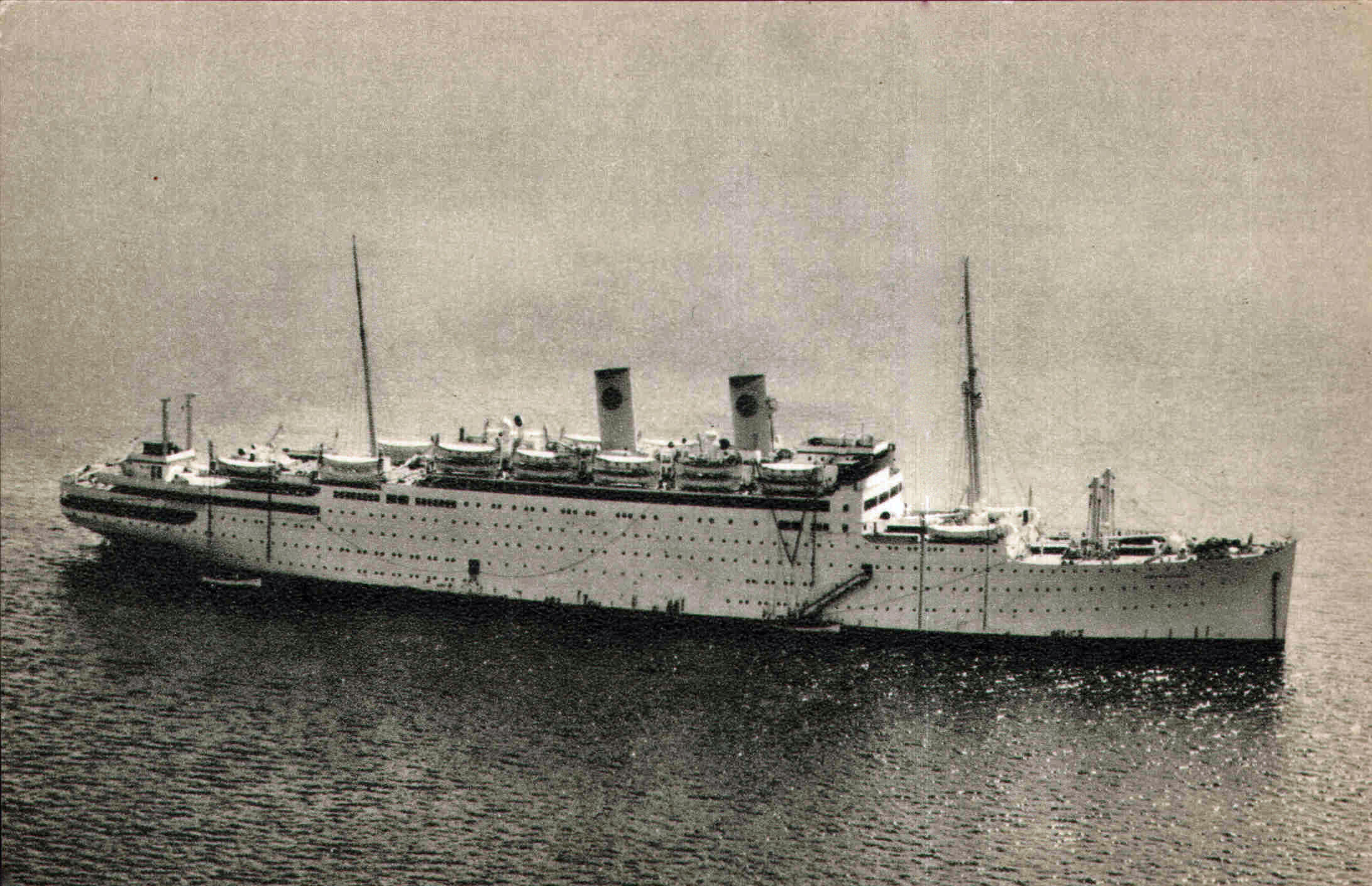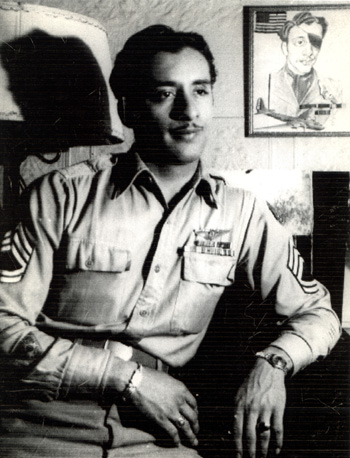T/SGT.
Clement Resto
..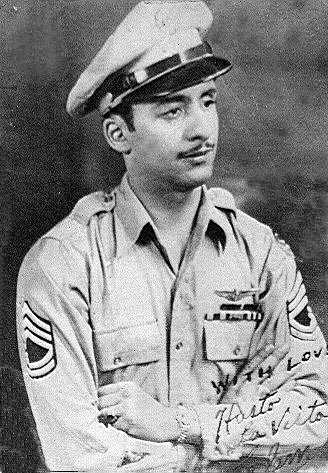
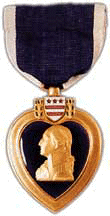
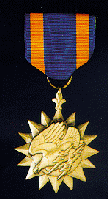
![]()
![]()
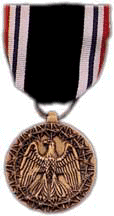
![]()
303rd Bomb Group
Squadron 358
This page is dedicated to my uncle Clement Resto who
served with the
303rd Bomb Group during World War II.
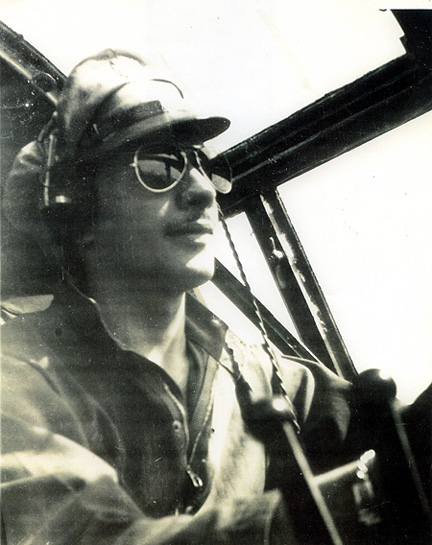
T/Sgt Clement Resto, 303rd Bomb Group, Squadron 358, September 20, 1943
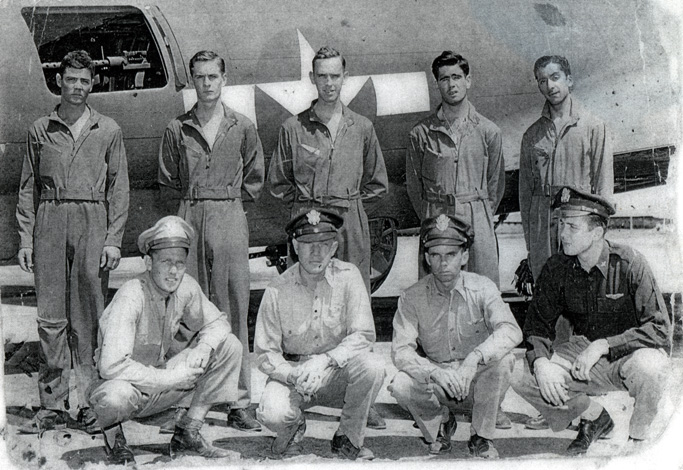
2/Lt. William R. Hartigan's Crew
2nd row - S/Sgt James T. Ince - S/Sgt Val F. Stoddard - T/Sgt Robert L. Ward - S/Sgt John W. Lowther - T/Sgt Clement Resto
1st row - 2/Lt Bernard F. Dorsey - 2/Lt Lorin F. Douthett - 2/Lt. Edward N. Goddard - 2/Lt William R. Hartigan
Clement Resto, as the engineer of Hartigan's Crew participated in seven missions during the war against Nazi Germany. The following combat mission reports are from the "The Molesworth Story" by the 303rd Bomb Group (H) Association and the 303rd Bomb Group site. To see more information about the crews and airplanes for all of the missions of the 303rd Bomb Group, follow the link at the bottom of this page to the 303rd Bomb Group site.
303rd BG (H) Combat Mission # 72
27 September 1943
Target: Port Area, Emden, Germany
Crews Dispatched : 20
Crews Lost: S/Sgt. W.E. Rein wounded by flak
Length of Mission: 5 hours, 50 minutes
Bomb Load; 40 M47A1 Incendiary bombs
Bombing Altitude; 25,000 ft
Ammo Fired; 6655 rounds
Eighth Air Force General Eaker was satisfied with the results of the Pathfinder practice missions of 23 and 25 September and decided to use the Emden mission as the first 8th Air Force operational use of Pathfinder aircraft. Emden was chosen as the first target because the contrasting reflections of water and land would show up on the H2S radar scopes more distinctly than any land target.
Group aircraft were loaded with 1,000 lb general purpose H.E. M-44 bombs and 100-lb M47A1 white phosphorous bombs. The 303rd BG(H) approached the target at 25,000 feet to find 7/10 to 10/10 cloud cover and eight to ten miles visibility. 1Lt Donald F. DeCamp in B-17 Star Dust, 358BS, aborted the mission when the No. 2 engine throttle linkage, vibrated apart and control of the engine was lost.
Due to an extremely steep, tight left turn immediately before the target was reached to avoid a heavy cloud at the bombing altitude, the 303 BG(H) formation was separated from the Combat Wing at the target. Bombing instructions were to adhere to the policy of dropping on the Pathfinder B-17s parachute flares with the lead Group bombing on the flares and other Groups dropping on the lead Group. The 303rd BG(H) lead ship bombardier 1Lt. Reinaldo J. Saiz, never saw bombs being dropped by the lead Group aircraft and was unable to drop his bombs. Suring the subsequent confusion, three Group aircraft dropped their bombs in the vicinity of the target area--two on the city of Norden, Germany, one near the island of Borkum and two jettisoned bombs into the North Sea.
Flak over the target was meager and inaccurate. Approximately 25 enemy fighters were seen. Their attacks were not persistent due to the excellent fighter protection given the Group by P-47s. There was one slight casualty. S/Sgt. W.E. Rein, tail gunner on Lt. Brinkley's crew in #42-5483 Red Ass 360BS, was hit by a small anti-aircraft gunfire splinter.
Many of the 303rd BG(H) crews were critical of the policy that required them only to drop bombs when the Group lead ship dropped theirs. They could have dropped their bombs on the Pathfinder ships' parachute flares that were clearly visible. They also requested that the Pathfinders "should get better organized" Groups in other Divisions had similar confusion and problems and most bombs fell far and wide from the target area.
AIR-SEA RESCUE MISSION: On the return trip to Emden several B-17's were seen in distress with parachutes observed. A hastily organized air-sea rescue effort was organized to search in two areas. The emergency timing gave little time for mission preparation and organization. Gee equipment, useful in over-water searches, was missing. Crews complained that they were not provided with food. The search was unsuccessful. The next day, a second air-sea rescue search was conducted by 10 B17s of the 358th and 427th BSs. Four areas were searched at an altitude of 300 to 500 feet. The wing of an RAF fighter and a small tethered balloon were observed. The search lasted about five hours. Returning crews suggested that further searches be conducted at an altitude of 1000 feet rather than lower altitudes.
303rd BG (H) Combat Mission No. 73
2 October 1943
Target: Port Area & Dock Facilities, Emden, Germany
Crews Dispatched: 20
Crews Lost: 1Lt. Paul Tippet, 11 crew KIA, 1 minor casualty
Length of Mission: 5 hours, 40 minutes
Bomb Load: 12 x 500 lb G.P. bombs + 16 bundles of nickels
Bombing Altitude: 23,500 ft
Ammo Fired: 10,915 rounds
Enemy Aircraft Claims: 1 Destroyed, 1 Probable
E
mden was the target again with a repeat mission. One aircraft aborted: #41-24561 The Duchess 359BS (Lt. Reeder) - The No. 3 engine had been feathered and would not start again. The ship aborted while the Group was forming.The bombers flew in perfect formation and made an excellent bomb run on the target. The bombs were dropped through overcast skies in close formation on the lead aircraft of the 384th BG(H). This aircraft was a Pathfinder aircraft whose "Mickey" operator made the bomb run with his H2S radar equipment. Parachute flares came out of the lead Combat Wing B-17, but they were not observed as opening. Fifty-seven tons of H.E. M-43 500-lb. G.P. bombs plus 16 bundles of "nickels" (propaganda leaflets) were dropped from 23,500 feet. This was the first time that the 303rd BG(H) dropped leaflets.
The formations were escorted in from the German coast and back out to the coast again by P-47 "Thunderbolt" fighters. All crews agreed that the fighters gave them perfect cover and kept most of the Nazi fighters out of reach of the bombers. Despite this cover, a few did manage to come through the formation and made several head-on attacks before they were chased away by 8th Air Force fighters. While there were many enemy fighters in the air, not more than six came in to make one of the most vigorous attacks yet seen by our crews. Anti-aircraft gunfire over the target was intense, but not very accurate.
Major Mitchell, Lead pilot in #42-29931 Satan’s Workshop reported, "We were flying perfect formation and when we hit the German coast, the P-47s were right there to meet us. They sure looked good and I might add that if they hadn't been with us we would have had a hell of a tough fight. Anyway, we went on over the target and dropped our bombs in as pretty a pattern as you will ever see. It was really beautiful to watch. Saw lots of Nazi fighters out there, but they were quite a distance away. There were only four that really
came in and made a pass at us. I saw them coming, so I told my ball turret gunner [S/Sgt. Clayton R. Bagwell] that I was going to lift up the nose when they came in so he could get a good shot at them. I did - and he let them have it. Two went down through the clouds smoking. All in all, it was a pretty good raid." Sgt Bagwell claimed an FW-190 as a damaged and 1Lt George E. Wright, flying in the tail gunner position, claimed an ME-109 as destroyed.
Maj. Glynn Shumake added, "Could see lots of enemy fighters out to one side of us, but our own fighters kept circling and covering us, so I guess they weren't too eager to move in too close, although about half a dozen did try it."
1Lt. Paul S. Tippet pilot of #42-5260 Yardbird II 360BS, was hit by two ME-109s immediately after the formation left the target. The ship peeled off, went down out of control and exploded above the overcast. One parachute was seen coming out of the ship before it went out of sight. All crew members were later confirmed as killed in action. The lost crew members were: 1Lt. Paul S. Tippet, 2Lt. Lewellyn H. Nemitz, 2Lt. Edwin E. Mims, 1Lt. Bernard Rice, T/Sgt. Oaks H. Smith, Sgt. Carney C. Rhodes, T/Sgt. Thomas L. Richardson, S/Sgt. Abraham J. Rasch, S/Sgt. Hugh F. Gibney, Jr., S/Sgt. William R. Greason and S/Sgt. Jack H. Randall. S/Sgt. Gibney is buried in Ardennes American Cemetery near Liege, Belgium.
303rd BG (H) Combat Mission No. 74
4 October 1943
Target: Aircraft Components Mfg. & Assembly Plant, Frankfurt, Germany
Crews Dispatched: 21
Crews Lost: 1Lt V.J. Loughnan crew, 2 minor casualties
Length of Mission: 6 hours, 15 minutes
Bomb Load: 12 x 1,000 lb G.P. plus M47A1 Incendiary bombs
Bombing Altitude: 23,500 ft
Ammo Fired: 51,360 rounds
Enemy Aircraft Claims: 6 Destroyed, 3 Probable's
F
rankfurt, Germany was today’s target. Six Group B-17s aborted the mission: #42-29894 Baltimore Bounce 359BS (Clifford) - The 427BS crew transferred to a spare aircraft and the pilot didn't have an oxygen mask.#42-5854
Alley Oop 360BS (Cogswell) and #42-5177 Fast Worker MK II 359BS(Hanselman) - The pilots thought they were short on gas.
#42-5788
A.O.G. Not in Stock 360BS (Baker) - The No. 3 engine had a runawayprop.
#41-24629
(No Name) 358BS (Hartigan) - The interphone was out and thesupercharger was lagging.
#42-5257
Miss Bea Haven 359BS (Brown) - The waist gunner became ill.
The lead bombardier, 1Lt. Byron K. Butt, overshot the IP when industrial haze and smoke made it difficult to observe. After several right turns they were back on the bomb run course. Bombs were dropped using the bombsight after a 25-second bomb run.
The fifteen remaining Group aircraft dropped 1,000-lb. bombs plus M47A1
incendiary bombs from 23,500 feet. Four aircraft also carried leaflets. The formation was escorted part of the way into enemy territory by P-47 fighters. However, for the roughest part of the trip–into Germany proper–the bombers flew unescorted. Fortunately, fighter opposition was not too intense at any time. There were about 20 to 25 enemy fighters observed during the unescorted portion of the trip. Most of the attacks came in head on, but not too close. ME-110s made rocket attacks from the rear but caused no damage. Moderate and inaccurate flak was encountered periodically on the way to the target and back.
Col. Stevens was pleased with the mission, stating, "It was a pretty good show. Those P-47s took us pretty well in and we went on from there alone. We flew into the target without too much trouble from the German fighters, although they were around. They didn't press their attacks as much as they have in the past. We dropped our bombs in a good pattern and got out." His pilot, Capt. Jacob C. James, added, "It was a good trip and I think that we did some good."
1Lt. Sumarlidason, pilot of the Meat Hound 359BS reported, "We saw about 20 to 25 fighters around and during the time we didn't have our P-47 escort. They would attack us off and on singly, but they didn't seem too eager. The P-47s really mixed it up with those Nazis. The bombing looked pretty darned good to me." S/Sgt. Jesse E. Trip, waist gunner on Mr. Five by Five said, "Fighters certainly gave us swell protection. Those Germans were amateurs compared to the ones up north."
One aircraft, #42-29846 (No Name) 359BS piloted by 1Lt. Victor J. Loughnan, was reported missing. It was last reported under control, flying on three engines about 12 miles south of Achen. Returning crewmen believed it had been hit by anti-aircraft fire. It was later learned that it was made inoperative when crewmen tossed out machine guns to lighten their load and one gun hit the No. 3 engine propeller. The crew parachuted southwest of Aachen, Germany, close to the Belgian lines. They were captured and taken to an air base near Aachen. Their B-17 crashed near St. Vith, Belgium. The crewmen were: 1Lt. Loughnan, 2Lt. Winfield H. Gredvig, 1Lt. James L.
Maxwell, 1Lt. Edward J. Pullman, T/Sgt. Eugene W. High, T/Sgt. Russell M. Daley, Jr., S/Sgt. Kenneth L. McGee, S/Sgt. Gordon E. Barr, S/Sgt. Paul C. Robillard and S/Sgt. Billy F. Knorpp.
303rd BG (H) Combat Mission No. 75
8 Oct 1943
Target: Center of City, Bremen, Germany
Crews Dispatched: 21
Length of Mission: 5 hours, 45 minutes
Bomb Load: 42 x 65 lb M47A2 Incendiary bombs
Bombing Altitude: 28,900 ft
Ammo Fired: 9,700 rounds
Black Week - 8-14 Oct 1943
T
he primary target was the important submarine-building yard at Bremen. During 1942, this yard produced 10.6% of total German production. On 8 October, there were 21 submarines under construction and 10 being fitted out. There were also four"Seetier" class destroyers being constructed and two being fitted out. The yard capacity had recently been increased by one slip. Another plant in Bremen was producing 75 JU-87 aircraft each month. The secondary target was the center of the city of Bremen.
Aircraft #41-24577 Hell's Angels turned back at the English coast when the pilot, Lt. John R. Johnston 358th BS, lost his No. 1 engine.
The effectiveness of the target smoke screen, in combination with a haze that extended to altitude, caused the Group to attack the secondary target. Twenty-seven tons of M47A1 65-lb. incendiary bombs were dropped from 28,000 feet and appeared to have landed east of the aiming point.
Flak in the target area was intense and accurate for Groups below the 303rd BG(H) formation. Both barrage and continuously pointed fire were employed. Meager inaccurate flak was met at various points to and from the target. Up to 300 enemy aircraft were seen, but there were very few attacks by the ME-109s, ME-110s and FW-190s. There were no claims made by the Group, no aircraft lost and no casualties. Nine aircraft suffered minor flak damage. Fighter support was good.
The lead pilot, Capt. Casello reported, "My crew saw bombs hitting on the center of town. There was a lot of flak, but the P-47s kept the enemy fighters away most of the time. We had a few tail attacks, but they didn't damage the ship any." "They definitely
haven't taken any flak away from Bremen." added Maj. Shayler. "We were lucky enough to fly above most of it, but it must have been hell for the boys flying below us. The flak was bursting fiercely down there. However, we weren't bothered much by fighters. They didn't seem to want to come up to our altitude and mix with the P-47s."
S/Sgt. Virgil E. Brown, tail gunner on Sky Wolf, said he saw three FW-190s attack one Fortress when the P-47s weren't around. "That tail gunner was really on the ball. He shot down two of the FWs in about thirty seconds and the other one turned around and got out of there fast," Sgt. Brown reported. S/Sgt. Chester Petrosky, tail gunner on Miss Bea Haven said, "I've never seen flak as thick as it was today. It looked like we could have gotten out and walked on it."
The crew of Star Dust 358BS, had the roughest Group trip of the day. Over the target flak hit the ship, damaged a supercharger and caused a runaway propeller. Flying on three engines, Star Dust fell behind the rest of the formation, but went on to bomb the target. Two bombs stuck in the racks and the bomb bay doors refused to close, slowing the ship down even more. To complicate matters, oxygen masks froze at the sub-zero
altitude. Bombardier Lt. Phillip A. Reed passed out from lack of oxygen. Engineer T/Sgt. Joseph A. Rozek went back to the bomb bay to try to close the doors and increase the speed of the ship a little. He dislodged the two bombs, which rolled out of the partially
closed doors. Then Sgt. Rozek passed out on the narrow catwalk over the open bomb bay doors five miles above earth. Seeing Sgt. Rozek's position, 2Lt. Roy C. Sanders, pilot of Star Dust, left the controls in the hands of the co-pilot 2Lt. Henry F. Nogash. After dragging Sgt. Rozek to a safer spot and fitting him up with an emergency oxygen system, Lt. Sanders went to the nose and succeeded in reviving Lt. Reed. "We were lucky to get back," the crew agreed. "We weren't in very good shape to keep off fighters, but those P- 47s were all around us. Boy! They really looked good–as welcome as a letter from home."
303rd BG (H) Combat Mission Report No. 76
The following is a description of the bombing of the Aircraft Component Plant at Anklam , Germany from the mission report, a mission that my uncle participated in. On that mission he served on the B17-F # 42-5264 "Yankee Doodle Dandy", everyone in the unit received letters of commendation for this mission, being that this was my uncle's fifth mission he received the Air Medal too. I thank Harry D. Gobrecht Lt.Col., USAF (RET), for allowing me to use material from his book "MIGHT IN FLIGHT" on this Web Site.
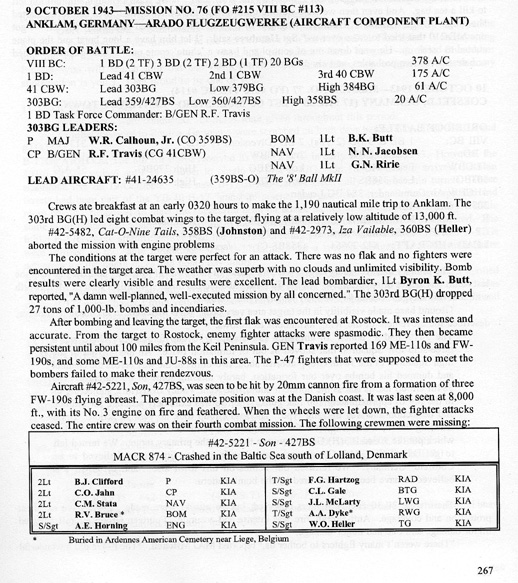
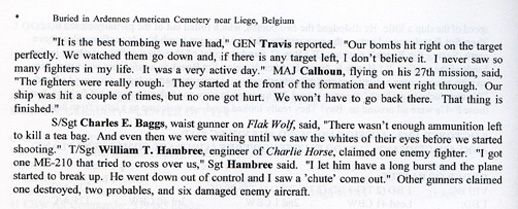
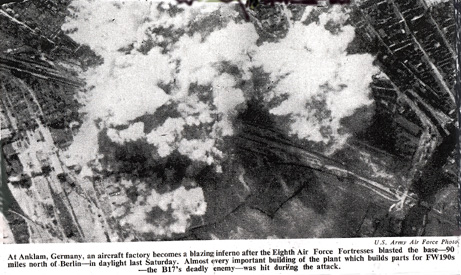
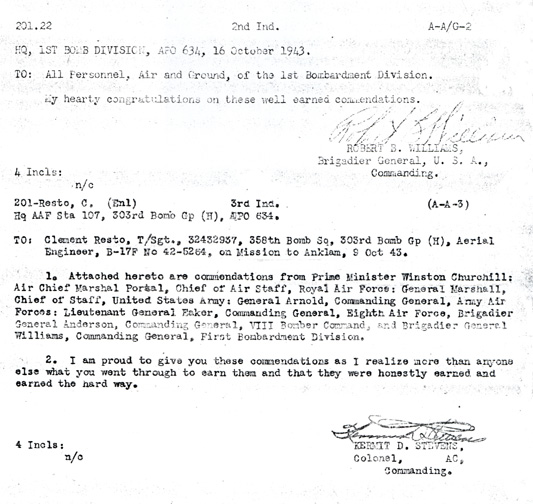
Commendations for Mission to Anklam, Germany
Click on images above to enlarge
303rd BG (H) Combat Mission No. 77
10 October 1943
Target: Center of city, Coesfeld, Germany
Crews Dispatched: 21
Length of Mission: 5 hours, 30 minutes
Bomb Load: 12 x 1,000 lb G.P. plus 38 x MA47A1 Incendiaries
Bombing Altitude: 24,650 ft
Ammo Fired: 7,120 rounds
Dispatches from Stockholm last night reported great fires blazing in the heart of Munster following Sunday's heavy raid by large formations of Flying Fortresses on the city of 143,000, the most important German railway head in the Ruhr and a major link with Ruhr-Emden Canal.
The Stockholm reports, quoting a Swedish correspondent in Berlin, said that the raid, which came on the heels of the Fortress and Liberator penetration deep into East Prussia and Poland, caught the Germans by "very great surprise."
Fliers returning to their bases in Britain said that the entire target area was blanketed with smoke and flames and that the raid was one of the most successful day assaults ever made over Europe.
Intense Fighter Opposition
Flak and fighter opposition was intense. The official Air Force communiqué claimed the Forts shot down 81 Nazi planes, while Thunderbolts which escorted the B17's on the 850 mile round trip destroyed 21. Against this total of 102 was the loss of 30 Forts and two P47s. Berlin radio claimed 40 Forts were shot down against a loss of 11 German fighters.
The USAAF heavies took a well deserved rest yesterday after their fifth big raid of the month carried them to Munster, a German Army garrison town which lies on the Dortmund-Ems canal and the Bremen-Cologne railroad - two important arteries carrying raw materials from North Sea ports to the industrial heart of the Reich.
As the Forts went over the target Sunday, the enemy attempted to set up a smoke shield to cover vital target areas. But something went wrong, the smoke blew in the wrong direction, and American crews reported excellent visibility for the bomb runs.
Even a Dornier as Fighter
In contrast to some recent raids, however, the Luftwaffe threw up swarms of fighters. Even a Dornier bomber joined the interceptors, according to 2/Lt Robert H Winnerman, 22, of Newark, bombardier on Slo Jo.
In the words of one flier, the Germans were "queuing up for us," and Capt. Robert B. Brown, 22, of Houston, Tex., pilot of Cabin in the Sky asserted; "You don't have to aim; just stick your gun out the window and pull the trigger. We're claiming 12 German fighters."
Mission # 79 Duren, Germany - Oct. 20, 1943
The following is a description of the mission that my uncle Clement was on when his ship was shot down. He lost an eye on this mission and spent the rest of the war as a POW in Stalag XVIIB. As a result of this mission he was awarded the Purple Heart and POW Medal.
2/Lt. William R. Hartigan's Crew
Left to right - 2/Lt William R. Hartigan - 2nd Lt. Edward N. Goddard - 2nd Lt. Lorin F. Douthett - 2nd Lt. Bernard F. Dorsey -
T/Sgt. Clement Resto - S/Sgt. John W. Lowther - T/Sgt. Robert L. Ward - S/Sgt. Val F. Stoddard - S/Sgt. James T. Ince
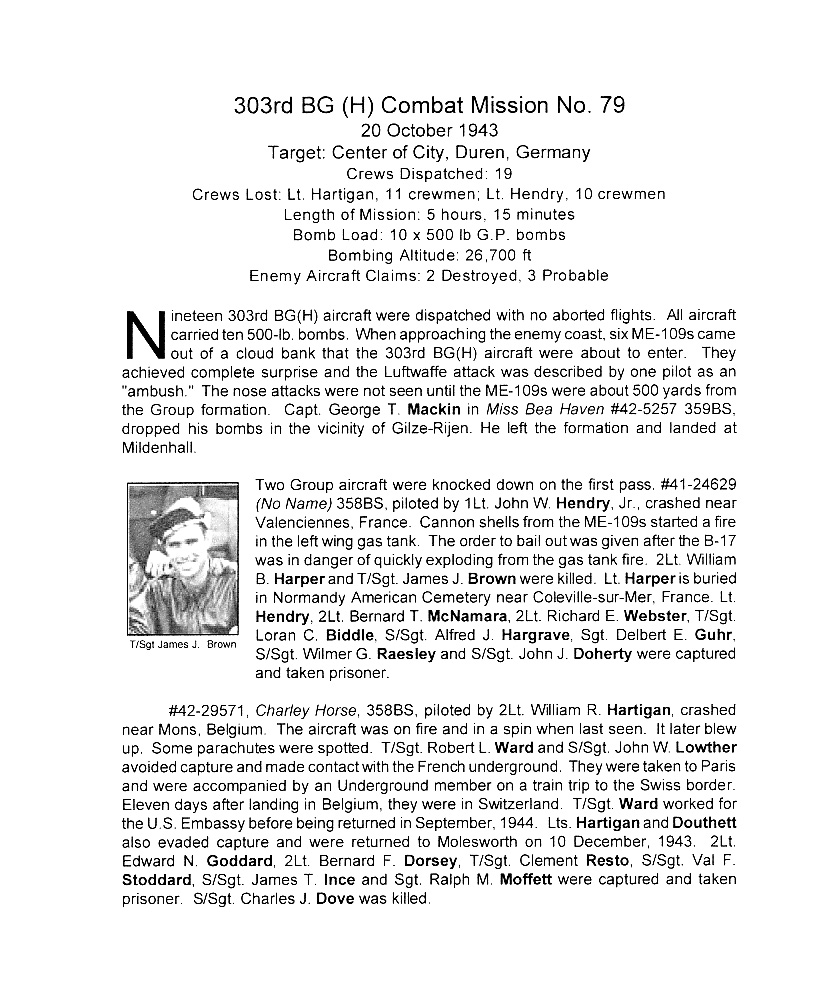
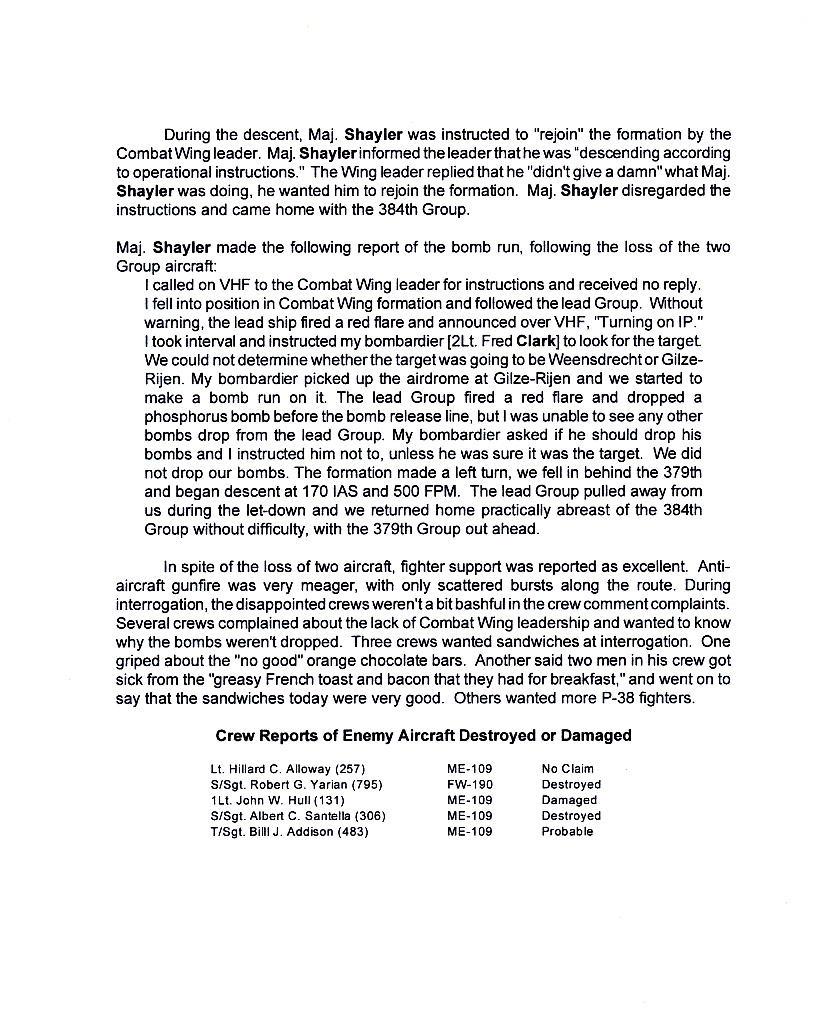
The Charley Horse B17F # 42-29571, was shot down during the bombing of Duren. Four members of the crew 2Lt. W.R. Hartigan, 2Lt. L.F. Douthett, T/Sgt. R.L Ward, and S/Sgt. J.W. Lowther, evaded capture. S/Sgt. Dove was killed in action. The rest of the crew 2Lt. B.F. Dorsey, 2Lt. E.N. Goddard, S/Sgt. J.T. Ince, T/Sgt. C. Resto, and S/Sgt V.F. Stoddard spent the rest of the war in POW camps.
My uncle Clement after bailing out landed in Belgium. A Belgian civilian named Leonard Mercier and members of the Belgian resistance helped him. Despite their efforts, nine days later, the Gestapo in Brussels, Belgium captured T/Sgt Clement Resto. Interrogated at Saint Giles Prison and in Frankfurt, Germany; he spent the rest of the war at Stalag Luft III & Stalag 17B. I will be posting a short story written by my uncle, about that experience. I am also hoping to be able to put more information about the members of the Belgian resistance who tried to help my uncle. At this point, I am gathering and organizing information.
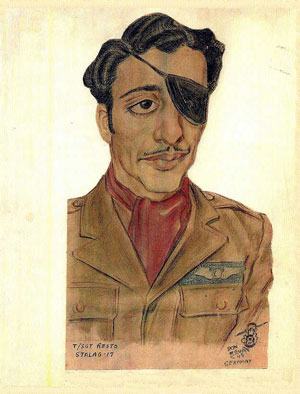
Caricuture of T/Sgt. Clement Resto
By Donald Bevan at Stalag XVIIB
Stalag 17B War Log - Clement Resto
This is a copy of my uncle Clem's war time log at Stalag 17B, Clem did a lot of the drawings in this log from personal experience, included are some of his writings reflecting his situation and his experience during the war (my two favorites in the log are "My race" and "My Future With Her"). A few of the drawings in this log he copied from drawings that other POW'S had done and some of the drawings and writings were done by fellow POW companions. The newspaper articles are from German newspapers (some in English). This slide show takes about a minute or more lo load up depending on the speed of your connection. Click on the image above to load the slide show. There are 121 pages in the log, sometimes the slide show loads up in the middle if this happens you can either right click to back track or left click to go forward with each click.
My uncle did the drawings in this slide show while he was a POW at Stalag 17B.
The slides take about 30 seconds to load.
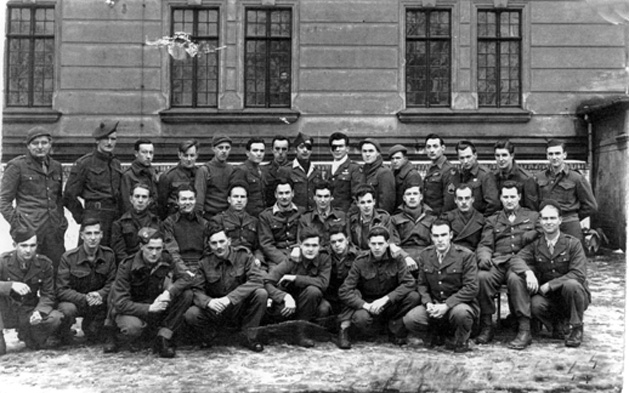
T/SGT Clem Resto in POW group photo
(last row 8th
left to right) taken in Berlin
November 4,1944 a few months before being repatriated.
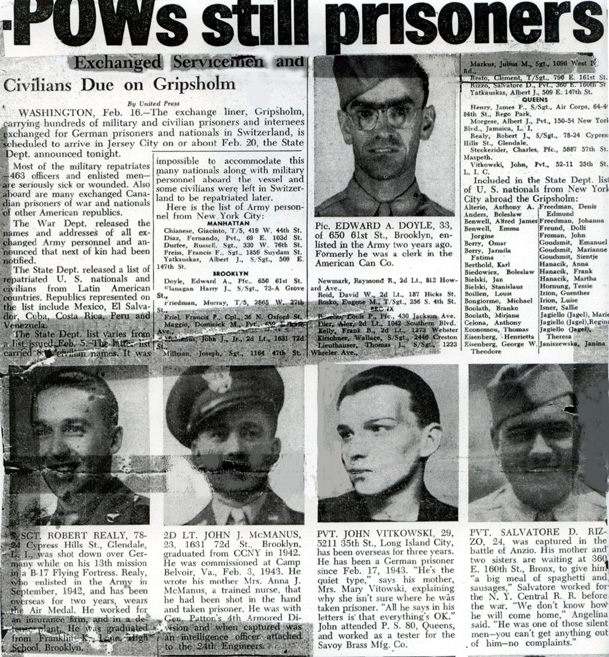
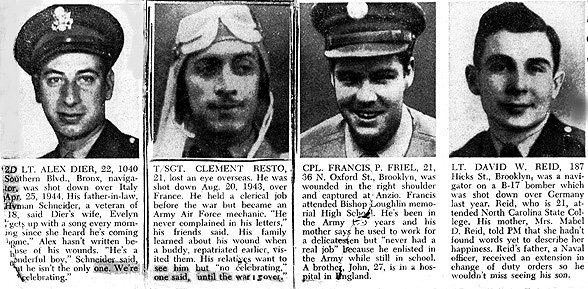
My uncle Clement was repatriated to the United States on the Exchange Liner Gripsholm, for more information on this ship click on the photo and you
will be taken to Lars Hemingstam's website which is dedicated to the Gripsholm and the Swedish American Line.
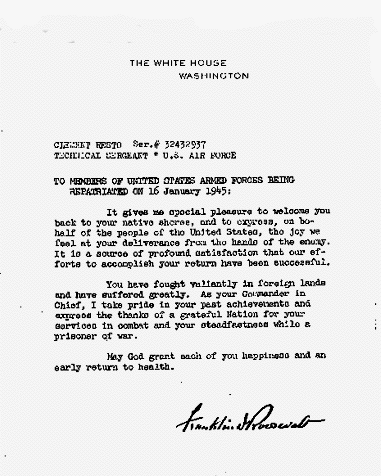
Letter of
repatriation from
President Franklyn D. Roosevelt
When my uncle T/Sgt Clement Resto was repatriated from Stalag 17B in early 1945, he brought home with him the names and addresses of about 400 fellow POW’s, so that he could write to their families to let them know that they were all right. He wrote to the families and they wrote back. I have about 200 + letters from those families which I am going to post on this page. As a child I always enjoyed reading the letters. I’ve been thinking that maybe the people that wrote the letters or their descendents would like reading them too. Included are letters from the family and friends. I will try to upload a few every day.
A Soldier Gets A Plastic Eye
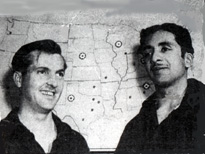
THE FITTINGS ARE COMPLETED. Sgt. Roland R Herbert
came from Camp Kilmer for a re-fitting.
Plastic eyes owe their origin to false teeth. The plastic compounds that appear in artificial dentures are the basic materials of the new prostheses (artificial eyes) that have proven so superior to the glass variety.
The plastic eye just had to be developed after World War II began, because the special glass for the older type of artificial eye was manufactured only in Germany. Major Victor M. Dietz, now chief of HGH’S Plastic Eye Section, and two other Army dental officers, created the new plastic prostheses at Valley Forge General Hospital.
The plastic eye is greatly superior to the glass prostheses. It is unbreakable: You can drop it, or step on it with your heel. The eyes look natural, and have every color of natural eyes, as near as possible to the anatomical structure where those colors appear in the real eye. They are like real eyes, and do not have the motionless stare so typical of the glass variety.
Halloran’s magnificent Plastic Eye Clinic and Laboratory is under the supervision of Major Dietz. NCO assistant to Major Dietz is Tec 4 David Grossberg. Sgt. Ellis Simpson does veining and modifying of eye color. T/Sgt. Robert B. Scott makes wax impressions which are cast in dental stone. All casts are reproduced by dental methods. Cpl. Bernard Greenwald and Pfc Richard M. Norman work in the plastic laboratory and do processing. The extremely delicate job of painting the irides in true, subtle natural colors is performed by Pfc Marvin Maurer.
Within the space limitations of this picture story, it is impossible to describe all the interesting and often, complicated details that taken together are responsible for the wonderful prostheses which is so realistic that only the expert can distinguished it from the real thing. We have just enough space to let you see what T/Sgt. Clement Resto, a patient, saw the day he came for his plastic eye. (Photos by Tec 5 Bill Baumbach. Major Dietz photo by Sgt. J. Pimper)
T/Sgt Clement Resto - Home again
